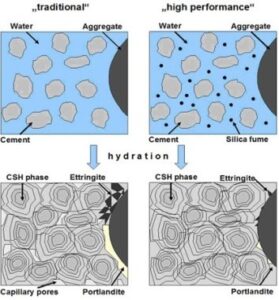
The economies of all countries now depend heavily on the long-term functioning of structures. Since the emergence of the Greek and Roman civilizations, concrete was the primary material for building dependable and durable infrastructure. Concrete’s compressive strength ranged from 13.8 to 27.6-41.4 Mpa at the turn of the 20th century, and in the 1960s.
Accelerated study into the microstructure of cements and concretes, as well as more complex rules and standards, were required due to deterioration, long-term poor performance, and inadequate resistance to hostile environments. As a result, superior cements and new materials like composites were created.
Today, concrete buildings with compressive strengths more than 138 Mpa are being constructed all over the world. Concrete of 800 Mpa or higher strengths are being made in research labs. The virtually complete elimination of voids in the concrete matrix, which are the primary source of the majority of problems that lead to deterioration, is one of the most notable characteristics of High performance concrete (HPC).
According to ACI, HPC is defined as “Concrete meeting special combinations of performance and uniformity requirements that cannot always be routinely achieved using conventional constituents and normal mixing, placing, and curing practises.”
Applications of high-performance concrete include:
- High-rise buildings and skyscrapers
- Bridges and infrastructure projects
- Dams and hydraulic structures
- Nuclear power plants
- Marine structures
- Industrial flooring and pavements
- Precast and prestressed concrete elements

